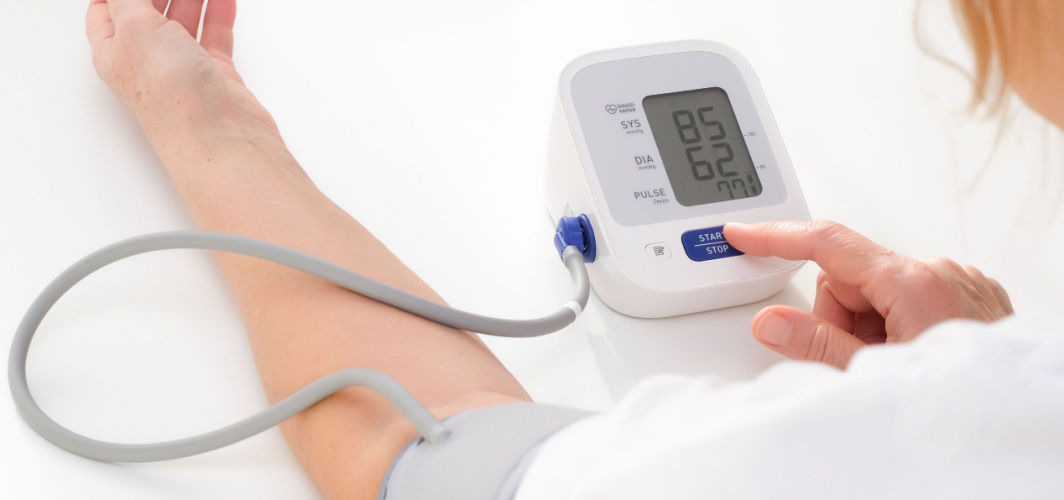General Health
Step-By-Step Guide: How To Measure Blood Pressure At Home
9 min read
By Apollo 24|7, Published on - 23 June 2023
Share this article
0
0 like

In healthcare, monitoring and managing one's blood pressure is of utmost importance. For individuals dealing with high blood pressure, regular monitoring is essential. With the advancements in technology and the growing emphasis on self-care, measuring blood pressure at home has become valuable in promoting overall well-being. By actively empowering individuals to engage in their health, a blood pressure machine helps people understand more about their cardiovascular health and enables early detection of potential risks.
What is Blood Pressure?
Blood pressure is the measure of the force exerted by blood as it circulates through the blood vessels when the heart pumps it across the body. It is typically represented by two numbers: systolic and diastolic pressure.
- The higher number (systolic) indicates the pressure when the heart contracts and pumps blood.
- The lower number (diastolic) represents the pressure when the heart rests between beats.
Together, these numbers provide valuable insights into the health of your cardiovascular system.
Why is it Important to Measure Blood Pressure at Home?
Importance of measuring blood pressure at home:
- Empowers individuals to monitor their cardiovascular health actively
- Enables early detection of potential risks and complications
- Facilitates tracking of blood pressure changes over time
- Assists in assessing the effectiveness of lifestyle modifications and treatments
- Helps healthcare providers prepare an effective plan for your hypertension management
- Promotes self-care and empowers individuals to take control of their health
- Helps prevent complications associated with high blood pressure such as a stroke
How to Measure Blood Pressure at Home?
Measuring blood pressure at home without needing clinic visits is now convenient. Home devices are user-friendly and provide accurate readings. They come in various types and offer numerous benefits, such as:
1. Digital Automatic Arm Blood Pressure Monitors
Benefits: These blood pressure machines are easy to use, give accurate readings, have a digital display, and may have extra features like memory storage and irregular heartbeat detection.
2. Wrist Blood Pressure Monitors
Benefits: Small and portable, convenient for home use, simple to operate, and provide quick readings, and some models have features like memory storage and irregular heartbeat detection (remember to position correctly for accuracy).
3. Bluetooth-Enabled Blood Pressure Monitors
Benefits: Connect to smartphones or tablets through Bluetooth, allow tracking and monitoring of readings using compatible apps, have user-friendly interfaces, and offer data visualisation for better tracking and analysis. Their accuracy may vary as they are not medical-grade devices.
4. Smartwatch Blood Pressure Monitors
Benefits: Include built-in blood pressure monitoring, continuously monitored throughout the day, and may have additional features like heart rate tracking and activity monitoring. Their accuracy may vary as they are not medical-grade devices.
How to Use a Home Blood Pressure Monitor?
To measure your blood pressure correctly, follow these steps:
1. Read the instruction manual: Familiarize yourself with your specific blood pressure monitor's features, buttons, and display.
2. Prepare and position yourself: Find a quiet and comfortable place to sit. Rest for a few minutes and remove any tight clothing that might interfere with the cuff placement.
3. Apply the cuff: Wrap the cuff snugly around your upper arm or wrist as the manufacturer instructs. Make sure it is properly positioned.
4. Start the measurement: Press the start button. The cuff will automatically inflate. Stay still and avoid movement or talking during the measurement.
5. Monitor the display: Watch the monitor's display as it measures your blood pressure. It should not be painful, but you may feel slight pressure or tightness from the cuff.
6. Read and record the results: Once the measurement is complete, note down the displayed systolic and diastolic readings and the date and time. Some monitors may store the readings automatically.
7. Repeat measurements if needed: Wait a few minutes and take additional measurements to confirm the accuracy or if you notice an unusual reading. Taking three consecutive readings and calculating the average can provide a more reliable result.
Also read: Why you should regularly check your blood pressure at home
Know Your Blood Pressure Range
Blood pressure is measured in millimetres of mercury (mmHg) and consists of systolic (higher number) and diastolic (lower number) pressure.
Blood Pressure Category |
Systolic Pressure(mmHg) |
Diastolic Pressure (mmHg) |
Description |
|
Normal |
Below 120 |
Below 80 |
Healthy blood pressure range |
|
Low |
Below 90 |
Below 60 |
It can vary based on individual factors. Some people have naturally low blood pressure without negative effects |
|
Elevated |
120-129 |
Below 80 |
Suggests an increased risk of developing high blood pressure |
|
Hypertension Stage 1 |
130-139 |
80-89 |
Indicates presence of high blood pressure, may require lifestyle changes |
|
Hypertension Stage 2 |
140 or higher |
90 or higher |
A more severe form of high blood pressure typically requires lifestyle changes and medications. |
Things to Know Before you Measure your Blood Pressure
Preparations before taking blood pressure measurements:
1. Rest for a few minutes: Sit quietly and relax briefly before checking your blood pressure. This helps make sure the reading is more accurate.
2. Avoid things that make your heart beat faster: Don't drink coffee or smoke cigarettes for at least 30 minutes before measuring your blood pressure. These things can make your blood pressure go up temporarily.
3. Use the bathroom first: Make sure your bladder is empty before measuring your blood pressure. Having a full bladder can affect the blood pressure reading.
4. Stick to the same time: Try to measure your blood pressure simultaneously every day. This gives you more consistent results and helps you see any changes over time.
5. Choose appropriate clothing: Wear comfortable, loose-fitting clothes that allow easy access to your upper arm. Remove tight sleeves or accessories that may interfere with the cuff placement.
6. Position your arm correctly: Keep your arm on a flat surface for the cuff to be at the same level as your heart. Ensure your arm is supported and relaxed and your palm is facing upward.
What can Affect your Blood Pressure Reading?
Factors that can affect blood pressure readings:
1. Caffeine
Drinking beverages high in caffeine, like coffee, tea, or energy drinks, can make your blood pressure rise for a little while. Hence, it's better to avoid caffeine before checking your blood pressure.
2. Physical activity
Doing exercise or activities that make you sweat can raise your blood pressure temporarily. Rest for at least 30 minutes before measuring your blood pressure.
3. Stress
Feeling stressed or having strong emotions, like being worried or angry, can cause a temporary increase in blood pressure. Try to relax and calm down before checking your blood pressure.
4. Smoking
Smoking cigarettes or using tobacco products can increase your blood pressure temporarily. It's a good idea to avoid smoking before checking your blood pressure.
How Often To Measure Your Blood Pressure?
To establish a baseline, measure your bp daily for a week in the morning and evening. Afterwards, you may reduce the frequency to once a week or according to your overall health. If your bp remains stable within a healthy range, measuring it once a month may be sufficient. Seek medical help if:
- Your blood pressure remains consistently high despite lifestyle modifications.
- You experience severe symptoms alongside your readings.
What do Blood Pressure Readings tell you?
Understanding the implications of high or low blood pressure is important for maintaining good health. Here's what you need to know:
1. High Blood Pressure
When your blood pressure is consistently too high, it puts extra strain on your arteries and organs, increasing the risk of heart disease, stroke, kidney problems, and other complications. High bp is usually called a ‘silent killer’ as it often shows no symptoms. Work with your healthcare provider to manage and control high blood pressure effectively.
Also read: Keeping High Blood Pressure In Check Is The Most Important Thing To Do! Here’s Why
2. Low Blood Pressure
Extremely low bp readings may require medical attention, especially if they are accompanied by symptoms like dizziness or fainting. Severely low bp can indicate an underlying health issue or inadequate blood flow to vital organs. Your healthcare provider can evaluate the underlying causes and recommend appropriate management strategies.
Also read: Low blood pressure (hypotension): Symptoms, causes, and treatment
When to Consult a Doctor?
If you have persistent high or low blood pressure, it is crucial to seek immediate medical attention. Look out for symptoms like severe headaches, chest pain, shortness of breath, or fainting. Consulting a healthcare professional is essential as they can offer guidance and appropriate treatment for your condition.
Conclusion
Monitoring your blood pressure at home allows you to take control of your cardiovascular health. Regular measurements and understanding your readings help you make informed decisions and maintain optimal blood pressure levels. For more information, talk to expert doctors.
FAQs
Q. How is blood pressure different from pulse?
Pulse measures the heart rate, indicating how many times the heart beats per minute. On the other hand, blood pressure measures the force with which the heart and blood vessels push blood throughout the body.
Q. Should I drink more water to lower blood pressure?
Staying hydrated by drinking six to eight glasses of water daily can improve blood pressure.
Q. When is blood pressure highest during the day?
It typically rises a few hours before waking up and continues to increase throughout the day, reaching its peak around midday. As the day progresses into the afternoon and evening, it tends to decrease. During sleep, it is generally lower.
Q. Which position gives the most accurate blood pressure reading?
For accurate blood pressure measurements, it's best to be seated upright with the arm used for measurement, resting alongside the body. Other positions, such as lying on one's side or assuming different postures, may cause inaccuracies.
Q. When should blood pressure not be measured?
Avoid measuring bp immediately after waking up. It's advisable to wait until after your morning routine and refrain from eating breakfast or taking medications. If you exercise upon waking, measure before engaging in physical activity.
Medically reviewed by Dr Sonia Bhatt.
General Health
Leave Comment
Recommended for you

General Health
Malaria: Symptoms, Cause, Diagnosis, Treatment, Prevention
Understand the causes, symptoms and diagnosis of Malaria. Learn about the personal protective measures to prevent this disease.

General Health
5 Diseases That Show No Signs And Symptoms But Can Kill You
While most diseases have symptoms, a few of them don't. This can be fatal because they remain largely undiagnosed. Being proactive about your health can help you prevent these silent killers.

General Health
Six Plant-Based Food Items That Replenish The Iron In Your Body
Plant-based foods have the potential to fulfil the iron requirements in your body. Read to know 6 such plant-based iron-rich foods.
Subscribe
Sign up for our free Health Library Daily Newsletter
Get doctor-approved health tips, news, and more.
Visual Stories

Plant-based Foods That Are a Great Source of Iron
Tap to continue exploring
Recommended for you

General Health
Malaria: Symptoms, Cause, Diagnosis, Treatment, Prevention
Understand the causes, symptoms and diagnosis of Malaria. Learn about the personal protective measures to prevent this disease.

General Health
5 Diseases That Show No Signs And Symptoms But Can Kill You
While most diseases have symptoms, a few of them don't. This can be fatal because they remain largely undiagnosed. Being proactive about your health can help you prevent these silent killers.

General Health
Six Plant-Based Food Items That Replenish The Iron In Your Body
Plant-based foods have the potential to fulfil the iron requirements in your body. Read to know 6 such plant-based iron-rich foods.